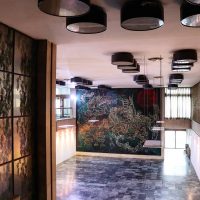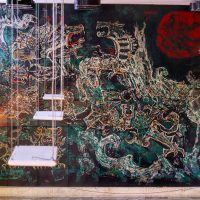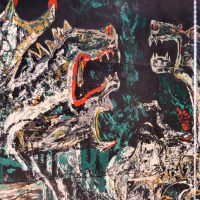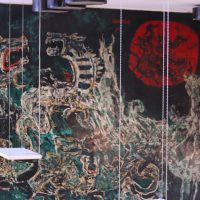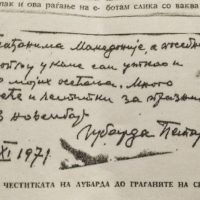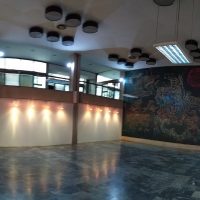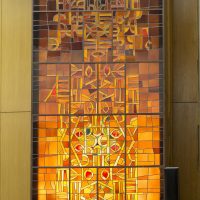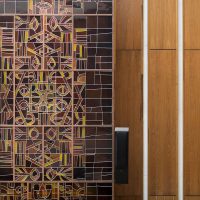Skopje Secret Spots – research project
The Skopje Secret Spots project began in April 2020 and is presented through a free platform on social networks. With an “online” presentation, the project, through photographs and short content, documents more than 100 buildings, paintings, architectural solutions and sculptures, located on several open public areas and interiors in public institutions. So far, there have been about 62 posts and it is planned to cover about 40 more cultural landmarks of the city, with a focus on works created in the period from the 1940ies to the 1990ies. Each post is dedicated to a specific event or author and contains brief information as a document about the event, the institution, the facility or the artwork.
The discovery of important cultural sites was based on the memory of places already seen, but without prior specific information about the erected “monument”. By researching the monographic editions of famous Macedonian and former Yugoslav artists and archives, content was added on what was the reason for placing a sculpture or bust, for example, when it was made, who is its author, why it was placed in that position etc. This research also includes and presents the monuments and memorials from the People’s Liberation War and the Revolution, memorial busts, park sculptures, interior designs and arrangements, specific architectural buildings and memorial houses where historically important people, scientists, artists, revolutionaries, etc. lived and worked.
The first uncovered work is the sculpture of Boro Mitrikjeski, Monument to the Fallen Fighters, on the 11 Oktomvri Boulevard. This was followed by works by famous Macedonian artists, such as: Dimo Todorovski, Jordan Grabuloski, Petar Hadži Boškov, Dragan Popovski Dada, Dimitar Kondovski, Tomo Šijak, Petar Mazev, Mile Korubin, Stefan Manevski, Borko Lazeska, Aneta Svetieva. Of course, the works of: Ivan Mirković, Petar Lubarda, Lojze Dolinar, Momcilo Krković, Andrzej Kasten and others were inevitable.
Skopje Secret Spots, in its cultural synthesis, also includes the architects: Gjorgje Gruin, Petar Moličkovski, Vjecislav Hudak, Ludek Kubeš, Dušan Pecovski, Janko Konstantinovski, Gorica Mandičeva, Milka Micevska, Kenzo Tange, Aleksandar Nikoljski and Vladimir Pota.
Namely, all “secret places” were photographed at several locations in Skopje, such as: City Park, Post Office 2, Army Hall, 8 Septemvri Hospital, Vardar Film, MANU, Makpetrol, Ironworks, Lake Treska, Metal Institute Tito, Hotel Bellevue, Stopanska Banka, Komercijalna Banka, libraries, schools and kindergartens, in positions most often used in closed and semi-closed spaces, such as entrance floors, lobbies, congress and ceremonial halls.
Every place, every city has its hidden places…
Sculpture is something we encounter when we pass by, the image and the object – when we step away to see them.
Cultural values influenced the view, until they began to disappear through the categories of space, time, and movement. With such thoughts, the idea for an educational-research project, Skopje Secret Spots is a result of spatial extension.
Given that a purely autonomous object has long been out of the focus of interest and increasingly difficult to visually perceive and sense, changing the view becomes history. Thus constructed reconstructed view, in a period of self-isolation, reveals marginalized “secret places”, supporting the integrity of cultural disciplines.
Urban living…
The reoriented template, in conditions of global, social changes and free time spent in isolation, were a trigger for the realization of this project. They initiated the formation of a “new” city in a seemingly different dimension than usual, a city in which all secret fragments and values came to light. Undoubtedly, Skopje is a city with inspiring spatial uniqueness. Hence, the idea of the project is to preserve all slightly forgotten monuments, works of art, architectural structures, sights and impressions and to restore all their legends analogously to one time and space.
Skopje and its surroundings from today’s aspect are rich with many cultural and historical monuments from the history of the city. A good part of them are dedicated to certain personalities who with their works have left deep traces in our historical past. Set in a public urban space, they are silent witnesses to some events related to the city.
Archiving…
One of the main reasons for the existence of this project is the building of a collective cultural memory through a collage of photographs and related stories. The approach to the lack of public matter leads to research that aims to encourage affirmation and spread of interest in culture. Through the “object-being” and shaping a different perspective narrated through legends, translated into stories and continuity of a time, the archiving is in the context of preserving the cultural heritage for future generations. This ideology, inspired by the absence of collective memories, creates a project that educates us to re-visualize public space.
The fragments from Skopje, which have been alive for decades, now look like a novelty. All those newly discovered places that are primarily archived through selectivity, are the most valuable representatives of the heritage of modern art and architecture of the city and urban reality in general.
The archiving of all “secret places” is planned, to be transferred from the “online” platform to paper, in the form of a publication.
Present and history…
If we talk about the cultural and artistic concept, embedded in a liberated urban environment, as for ideology, the coherent images of that concept form a city.
The history of the city determines the modern society.
The monument can mark, celebrate, remind of various events and the participants in them and, like any other document of civilization, remains upright forever, regardless of the intention, as a document of a completed action, dedicated to a historical moment. For this reason, the aesthetics of these objects must be valorized in relation to their inevitable importance as symbols. Also, all the works that are part of this project, are part of a general reality, of a public space or academic communities and in themselves are witnesses of different directions and styles.
According to architectural theorists, the monuments of the People’s Liberation Struggle (PLS), for example, have extraordinary artistic value and are a testament to the breakthrough of modernism and the specific political position of a bygone system, Yugoslavia. Those monuments had a dual nature – they celebrated the victims of fascism and glorified the Revolution. Today, the community’s attitude towards these monuments is in line with another aspect of monument architecture: many have been destroyed and others have been neglected or considered an unwanted legacy by the post-war local political scene.
For example, the Mavrovo resort, through a promotional commercial action, painted the monument in Staro Bacilo in Mavrovo. The work of the architect Radovan Radjenović, which also has a pedestal (dating from the 1970ies), with a mosaic by the famous artist Gligor Čemerski, whose works have been declared cultural heritage, was marked with graffiti “Inhale Mavrovo” for the purpose of local tourism. The painted wall is not a private property, but part of an articulated artistic whole.
Because of all this, this project will serve as a lasting archival material and educational example in creating a sense of respect for historical values and a continuity of a city that has lived and will live on the foundations of events and great people who participated in building those values.
The attitude towards cultural heritage and cultural values is something that is emanated in closed professional circles (artists, architects, art historians, academics). Therefore, the ultimate goals of this project are in the format of public education, to distinguish the absolute right to private property and what is the cultural value of that property, to protected cultural monuments and public good in public space.
With the realization of this project, communication is underway for cooperation with representatives of the Cultural Heritage Administration, to lead a discussion on the question (which is actually the purpose of this research), “What is cultural heritage and how to preserve it?”
Interaction, object-subject…
The research, as a basis for the realization of such a project, took place and takes place daily in public space and in institutions and facilities. Namely, one act of research is that the society and its dynamics are undoubtedly in constant communication with the public space. All works that are part of this project, are selected and are related to communication between the viewer-visitor and the object placed in a certain space. The impression of certain cultural landmarks, documented through professional photography, gives a monumental overview of the works of art and a development of the Macedonian art and the artists who created and still create that scene. The discovery of all the “secret” forgotten places, related to designers, artists, architects, etc., simply conceived in an open-air exhibition, forms the permanent exhibition of Skopje Secret Spots.
Most of the stories, legends and artists who with their creativity instilled spirit in those monuments, works, objects, have been forgotten over time and no one pays attention to them anymore, nor does they know why they stand in that particular place. The space observed by the subject is collectively in some everyday pattern and that is why the subject does not visualize everything he/she encounters. This raises many questions: What are they? Who erected those monuments, works, objects? Why are they in that place? Who is the author? What is the purpose? Why is there no explanation? Does art exist for itself?
This educational research is shaped according to the works, it revives and preserves all references and restores the original meaning and role of all those who participated specifically in this project, in this exhibition called Skopje. Also, the project, through the daily “online” posing of visual material, brings closer to the recipient (subject, passer-by) the space that occurs between him/her and the object (work). Thus, the consumed culture distorts the generated image and creates the impression of domination of the image (work) with consequent references to it.
The impact of social networks…
We live in a time when most people simply do not read long texts, so the information in the posts is short and is a good way of communication, such as а status of social networks (Facebook and Instagram) presented with visual material, photos. The visual material creates a mutual interaction between the post, the reader and the object, thus stimulating human curiosity and a sense of exploration and anticipation of the true work of art in space. (First post, 23.04.2020)
Тranslated to English: Zorica Teofilova


